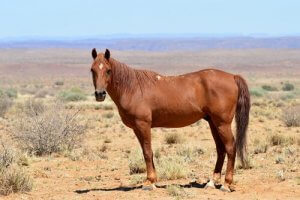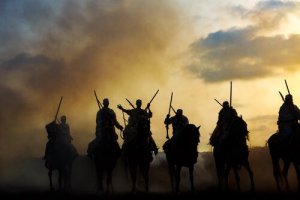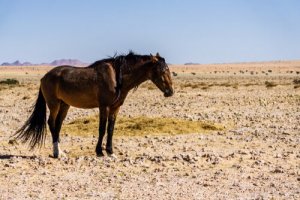The Horses of Africa: An Evolutionary Success Story


Written and verified by the lawyer Francisco María García
People often associate Africa with exotic animals such as lions, rhinos and giraffes. However, the horses of Africa also have a rich and interesting history and are a great example of how an animal can evolve and adapt to new and hostile terrain.
In this article, we’ll tell you all about the history of Africa’s horses, focusing particularly on the Barb horse.
Horses of Africa: the Barb
The Barb is one of Africa’s best-known horse breeds. Its strength and ability to adapt meant that these horses quickly spread throughout the Maghreb. Many were tamed by local tribesmen, who mainly lived in the central regions of North Africa.
There are many stories and beliefs surrounding the birth of the Barb in African mythology. However, we actually know very little about their origins. Some experts have concluded that its ancestors may have been wild horses that survived the ice age.
According to legend, Arabian invaders arriving in the ancient region of Barbary (which stretched from modern-day Algeria to the Libyan border) were fascinated by these “semi-wild” horses.
Captivated by their strength, elegance, agility and stamina, Middle Eastern conquerors decided to use these horses in their army. It wasn’t long before they began to cross these wild horses with their native Arabian horses. This gave birth to the first “cross-breeds” and may well have influenced the modern-day Arab horse.

The war history of the Barb
Because of its strategic position in relation to Europe, North Africa has seen many bloody wars throughout history. Up until the 1950s, people often used Barbs on the battlefield.
When conflict in North Africa started to abate between the 50s and 60s, these horses suddenly found themselves at risk of extinction. As they weren’t normally used for travel, and the constant fighting and poor soil conditions meant farming activity was limited, the number of Barb horses fell drastically.
Things only began to improve thanks to an initiative launched by an Algerian horse breeder. In 1987, he founded the Organisation Mondiale du Cheval Barbe (the World Barb Horse Organization). However, today’s Barb looks very different to the original, with a larger and more robust physique than its ancestors.
Horses of Africa: Namibian horses
At first, the horses of Namibia were seen as an invasive species that could disrupt the scant population of local flora and fauna. In fact, there was even a debate as to whether or not the horses should be culled.
However, the horses’ ability to adapt to this new and challenging terrain caught the attention of both locals and scientists. These “invasive” horses are one of the few species of equine that have managed to survive in a desert environment.

After conducting a series of studies and tests, scientists observed that their ability to adapt was the result of several morphological and physiological changes in the horse’s body.
Physical changes
If you analyze their morphology, you will find that the horses of Namibia are smaller than the standard African horse. Furthermore, their efficient renal function means they produce less urine, and need to drink far less water than horses in other countries.
This amazing transformation has lead experts to wonder what impact climate change would have on animals, especially mammals.
Could the horse’s constitution help it survive in other hostile habitats? We don’t yet have the answers to these complex questions. But the history and great adaptability of the African horse can’t be overlooked.
Meanwhile, the “invasive” horses of Africa have become a popular tourist attraction in Namibia and the surrounding area. Today, their numbers are on the rise, now totaling over 300 animals. As always, these horses appear to have adapted well to the constant presence of curious onlookers.
People often associate Africa with exotic animals such as lions, rhinos and giraffes. However, the horses of Africa also have a rich and interesting history and are a great example of how an animal can evolve and adapt to new and hostile terrain.
In this article, we’ll tell you all about the history of Africa’s horses, focusing particularly on the Barb horse.
Horses of Africa: the Barb
The Barb is one of Africa’s best-known horse breeds. Its strength and ability to adapt meant that these horses quickly spread throughout the Maghreb. Many were tamed by local tribesmen, who mainly lived in the central regions of North Africa.
There are many stories and beliefs surrounding the birth of the Barb in African mythology. However, we actually know very little about their origins. Some experts have concluded that its ancestors may have been wild horses that survived the ice age.
According to legend, Arabian invaders arriving in the ancient region of Barbary (which stretched from modern-day Algeria to the Libyan border) were fascinated by these “semi-wild” horses.
Captivated by their strength, elegance, agility and stamina, Middle Eastern conquerors decided to use these horses in their army. It wasn’t long before they began to cross these wild horses with their native Arabian horses. This gave birth to the first “cross-breeds” and may well have influenced the modern-day Arab horse.

The war history of the Barb
Because of its strategic position in relation to Europe, North Africa has seen many bloody wars throughout history. Up until the 1950s, people often used Barbs on the battlefield.
When conflict in North Africa started to abate between the 50s and 60s, these horses suddenly found themselves at risk of extinction. As they weren’t normally used for travel, and the constant fighting and poor soil conditions meant farming activity was limited, the number of Barb horses fell drastically.
Things only began to improve thanks to an initiative launched by an Algerian horse breeder. In 1987, he founded the Organisation Mondiale du Cheval Barbe (the World Barb Horse Organization). However, today’s Barb looks very different to the original, with a larger and more robust physique than its ancestors.
Horses of Africa: Namibian horses
At first, the horses of Namibia were seen as an invasive species that could disrupt the scant population of local flora and fauna. In fact, there was even a debate as to whether or not the horses should be culled.
However, the horses’ ability to adapt to this new and challenging terrain caught the attention of both locals and scientists. These “invasive” horses are one of the few species of equine that have managed to survive in a desert environment.

After conducting a series of studies and tests, scientists observed that their ability to adapt was the result of several morphological and physiological changes in the horse’s body.
Physical changes
If you analyze their morphology, you will find that the horses of Namibia are smaller than the standard African horse. Furthermore, their efficient renal function means they produce less urine, and need to drink far less water than horses in other countries.
This amazing transformation has lead experts to wonder what impact climate change would have on animals, especially mammals.
Could the horse’s constitution help it survive in other hostile habitats? We don’t yet have the answers to these complex questions. But the history and great adaptability of the African horse can’t be overlooked.
Meanwhile, the “invasive” horses of Africa have become a popular tourist attraction in Namibia and the surrounding area. Today, their numbers are on the rise, now totaling over 300 animals. As always, these horses appear to have adapted well to the constant presence of curious onlookers.
This text is provided for informational purposes only and does not replace consultation with a professional. If in doubt, consult your specialist.








